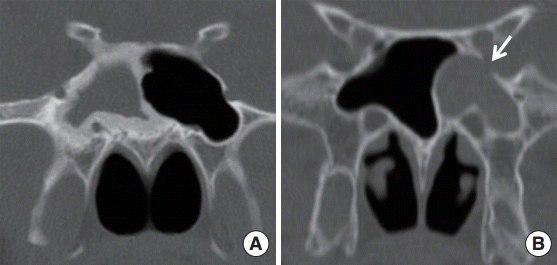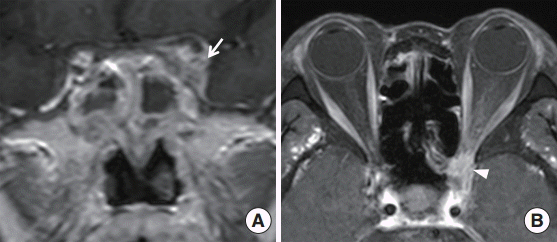1. deShazo RD, Chapin K, Swain RE. Fungal sinusitis. N Engl J Med. 1997; Jul. 337(4):254–9.

2. Park GY, Kim HY, Min JY, Dhong HJ, Chung SK. Endodontic treatment: a significant risk factor for the development of maxillary fungal ball. Clin Exp Otorhinolaryngol. 2010; Sep. 3(3):136–40.

3. Kwon MO, Kim KS. Headache induced by isolated sphenoid fungal sinusitis: sinus headache? J Headache Pain. 2009; Dec. 10(6):473–6.

4. Karkas A, Rtail R, Reyt E, Timi N, Righini CA. Sphenoid sinus fungus ball. Eur Arch Otorhinolaryngol. 2013; Mar. 270(3):893–8.

5. Lawson W, Reino AJ. Isolated sphenoid sinus disease: an analysis of 132 cases. Laryngoscope. 1997; Dec. 107(12 Pt 1):1590–5.

6. DeLano MC, Fun FY, Zinreich SJ. Relationship of the optic nerve to the posterior paranasal sinuses: a CT anatomic study. AJNR Am J Neuroradiol. 1996; Apr. 17(4):669–75.

7. Heskova G, Mellova Y, Holomanova A, Vybohova D, Kunertova L, Marcekova M, et al. Assessment of the relation of the optic nerve to the posterior ethmoid and sphenoid sinuses by computed tomography. Biomed Pap Med Fac Univ Palacky Olomouc Czech Repub. 2009; Jun. 153(2):149–52.

8. Lew D, Southwick FS, Montgomery WW, Weber AL, Baker AS. Sphenoid sinusitis: a review of 30 cases. N Engl J Med. 1983; Nov. 309(19):1149–54.
9. Pagella F, Pusateri A, Matti E, Giourgos G, Cavanna C, De Bernardi F, et al. Sphenoid sinus fungus ball: our experience. Am J Rhinol Allergy. 2011; Jul-Aug. 25(4):276–80.

10. Pagella F, Matti E, De Bernardi F, Semino L, Cavanna C, Marone P, et al. Paranasal sinus fungus ball: diagnosis and management. Mycoses. 2007; Nov. 50(6):451–6.

11. Friedman A, Batra PS, Fakhri S, Citardi MJ, Lanza DC. Isolated sphenoid sinus disease: etiology and management. Otolaryngol Head Neck Surg. 2005; Oct. 133(4):544–50.

12. Klossek JM, Peloquin L, Fourcroy PJ, Ferrie JC, Fontanel JP. Aspergillomas of the sphenoid sinus: a series of 10 cases treated by endoscopic sinus surgery. Rhinology. 1996; Sep. 34(3):179–83.
13. Socher JA, Cassano M, Filheiro CA, Cassano P, Felippu A. Diagnosis and treatment of isolated sphenoid sinus disease: a review of 109 cases. Acta Otolaryngol. 2008; Sep. 128(9):1004–10.

14. Toussain G, Botterel F, Alsamad IA, Zerah-Lancner F, Pruliere-Escabasse V, Coste A, et al. Sinus fungal balls: characteristics and management in patients with host factors for invasive infection. Rhinology. 2012; Sep. 50(3):269–76.

15. Grosjean P, Weber R. Fungus balls of the paranasal sinuses: a review. Eur Arch Otorhinolaryngol. 2007; May. 264(5):461–70.

16. Gilain L, Aidan D, Coste A, Peynegre R. Functional endoscopic sinus surgery for isolated sphenoid sinus disease. Head Neck. 1994; Sep-Oct. 16(5):433–7.

17. Postma GN, Chole RA, Nemzek WR. Reversible blindness secondary to acute sphenoid sinusitis. Otolaryngol Head Neck Surg. 1995; Jun. 112(6):742–6.

18. Ferguson BJ. Fungus balls of the paranasal sinuses. Otolaryngol Clin North Am. 2000; Apr. 33(2):389–98.

19. Rowe-Jones JM, Moore-Gillon V. Destructive noninvasive paranasal sinus aspergillosis: component of a spectrum of disease. J Otolaryngol. 1994; Apr. 23(2):92–6.
20. Klossek JM, Serrano E, Peloquin L, Percodani J, Fontanel JP, Pessey JJ. Functional endoscopic sinus surgery and 109 mycetomas of paranasal sinuses. Laryngoscope. 1997; Jan. 107(1):112–7.

21. Fisher BD, Armstrong D, Yu B, Gold JW. Invasive aspergillosis: progress in early diagnosis and treatment. Am J Med. 1981; Oct. 71(4):571–7.
22. Lee LA, Huang CC, Lee TJ. Prolonged visual disturbance secondary to isolated sphenoid sinus disease. Laryngoscope. 2004; Jun. 114(6):986–90.

23. Patt BS, Manning SC. Blindness resulting from orbital complications of sinusitis. Otolaryngol Head Neck Surg. 1991; Jun. 104(6):789–95.

24. Hu L, Wang D, Yu H. Isolated sphenoid fungal sinusitis and vision loss: the case for early intervention. J Laryngol Otol. 2009; Feb. 123(2):e8.







 PDF
PDF Citation
Citation Print
Print


 XML Download
XML Download